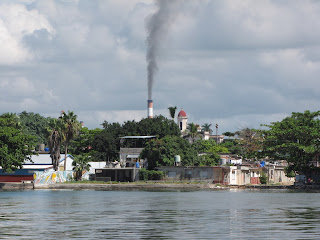Once again we were back at the Viazul bus terminal to take a bus to Cienfuegos. This was the only town where no one responded to our requests for a casa and Rafael had a friend he phoned who would meet us at the bus station and put us up. It seems that many people in Cuba now use Airbnb. One person told us that she had instant bookings on the website and although she had accepted us, she could not host us because she was too slow updating her online bookings and Airbnb charges hefty fees if a booking is cancelled.
The landscape on the way to Cienfuegos was flat with lots of fields flooded for rice in different stages of growth. In areas unsuited to rice there were sugar cane plantations. Rafael told us that the government closed 10 sugar refineries because the machinery was too old and inefficient. A lot of the land we passed was government owned. There were several dams holding water for irrigation.
Cienfuegos was a city settled by the French and has a population of about 18,000. It is an industrial city with petroleum, chemical and cement industries. We could see the smokey chimney as we arrived.
 |
| The front of the casa with the terrace above |
Our host Yhanes met us at the bus station. As we left he gave the security guard a tip for letting him into the station. He and his wife looked like they were in their late 70's. They employed a couple of maids. He had been an electrician for a government factory before his retirement. All retirees get a government pension.
 |
| The ridge is where the house ended. The red rails come up from the house to the terrace where we had breakfast. The tall building is an abandoned school. |
The house was very narrow with a long corridor and windows on one side. It was joined to another house with an opposite layout. The living area of the house looked onto the busy noisy street and Yhanes and his wife would sit here rocking in their chairs and chatting to the locals who walked by.
 |
| Yhanes and Teresita |
We were not offered meals but Yhanes took us to a couple of restaurants a short walk away. One had all its pork, chicken and beef covered in breadcrumbs and deep fried, in a cordon bleu style. Unfortunately mine was not quite cooked through and I had to complain to the owner - the restaurant was in her front room. Yhanes was sorry to hear about it as it is his favourite restaurant. Another time we ate at a farm themed place that had stewed country food more to my liking as it was well stewed. My dish was called 'vieja ropa' or old clothes!
 |
| Breakfast on the terrace |
We walked about the old city and it has a nice pedestrian street running through the middle. Every second shop in the walking street was a government Panamerica store. There is no advertising like we know other than the name of the place. The city was made a UNESCO World Heritage site in 2005. It was founded in 1819 by the French. A lot of the French influenced buildings have been renovated. We saw 21 buses lined up by the cruise ship anchored in the port and the buses ferried visitors to various parts of the city.
Yhanes told us not to swim near the Malecon, beach promenade, as it is polluted. He was not wrong. In the 33 degree temperatures the fumes from the sewerage that flows into the harbour were so potent we could smell them from the other side of the street. These are the kinds of infrastructure problems that Cuba has got to solve and of course they will cost a lot of money and be complicated to manage.
 |
| A well shaded fruit and vegetable mobile trader on the malecon |
I think of central Cienfuegos as the painted human statues city because there were lots of them in various parts of the city hoping to get tourists to leave them money when they were photographed.
 |
| Check out the silver cowboy |
Yhanes suggested we take the ferry to the Castilla de Jagua. It is a fort that was built in 1745 to protect the bay from invaders. The ferry was absolutely crowded and it was stinking hot. The area near the fort was inhabited by residents that used to work at the nuclear plant but the plant has now closed down and the residents have to commute to other parts of the bay for employment. The inside of the ferry was covered and crowded so we ended up outside where we and the locals opened up umbrellas to protect ourselves from the burning sun. Luckily we had a seat in the shade on the journey home.
 |
| Castilla de Jagua |
The fort has been renovated and the signs were mostly in Spanish and not many of the exhibits were original. The guide only spoke Spanish it was quite expensive to look around. However, it was interesting to see that as well as the British, French and Spanish they had also been visited by the Dutch and Danish.
This is one of the people transporters with no air conditioning and lots of people sitting on the floor or standing holding onto a rail in the aisle.
As soon as the sun starts to rise the streets rattle with the clip clop of the horses and carts. Here are three forms of transport we spotted while having breakfast on the terrace.














No comments:
Post a Comment